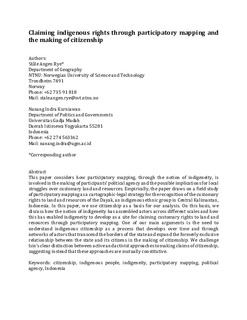| dc.contributor.author | Rye, Ståle Angen | |
| dc.contributor.author | Kurniawan, Nanang Indra | |
| dc.date.accessioned | 2017-12-12T09:03:14Z | |
| dc.date.available | 2017-12-12T09:03:14Z | |
| dc.date.created | 2017-09-05T09:59:38Z | |
| dc.date.issued | 2017 | |
| dc.identifier.citation | Political Geography. 2017, 61 148-159. | nb_NO |
| dc.identifier.issn | 0962-6298 | |
| dc.identifier.uri | http://hdl.handle.net/11250/2470548 | |
| dc.description.abstract | This paper considers how participatory mapping, through the notion of indigeneity, is involved in the making of participants' political agency and the possible implications for local struggles over customary land and resources. Empirically, the paper draws on a field study of participatory mapping as a cartographic-legal strategy for the recognition of the customary rights to land and resources of the Dayak, an indigenous ethnic group in Central Kalimantan, Indonesia. In this paper, we use citizenship as a basis for our analysis. On this basis, we discuss how the notion of indigeneity has assembled actors across different scales and how this has enabled indigeneity to develop as a site for claiming customary rights to land and resources through participatory mapping. One of our main arguments is the need to understand indigenous citizenship as a process that develops over time and through networks of actors that transcend the borders of the state and expand the formerly exclusive relationship between the state and its citizens in the making of citizenship. We challenge Isin's clear distinction between active and activist approaches to making claims of citizenship, suggesting instead that these approaches are mutually constitutive. | nb_NO |
| dc.language.iso | eng | nb_NO |
| dc.publisher | Elsevier | nb_NO |
| dc.rights | Attribution-NonCommercial-NoDerivatives 4.0 Internasjonal | * |
| dc.rights.uri | http://creativecommons.org/licenses/by-nc-nd/4.0/deed.no | * |
| dc.title | Claiming indigenous rights through participatory mapping and the making of citizenship | nb_NO |
| dc.type | Journal article | nb_NO |
| dc.type | Peer reviewed | nb_NO |
| dc.description.version | acceptedVersion | nb_NO |
| dc.source.pagenumber | 148-159 | nb_NO |
| dc.source.volume | 61 | nb_NO |
| dc.source.journal | Political Geography | nb_NO |
| dc.identifier.doi | 10.1016/j.polgeo.2017.08.008 | |
| dc.identifier.cristin | 1490981 | |
| dc.description.localcode | © 2017. This is the authors’ accepted and refereed manuscript to the article. Locked until 30.8.2019 due to copyright restrictions. This manuscript version is made available under the CC-BY-NC-ND 4.0 license http://creativecommons.org/licenses/by-nc-nd/4.0/ | nb_NO |
| cristin.unitcode | 194,67,10,0 | |
| cristin.unitname | Institutt for geografi | |
| cristin.ispublished | true | |
| cristin.fulltext | postprint | |
| cristin.qualitycode | 2 | |

